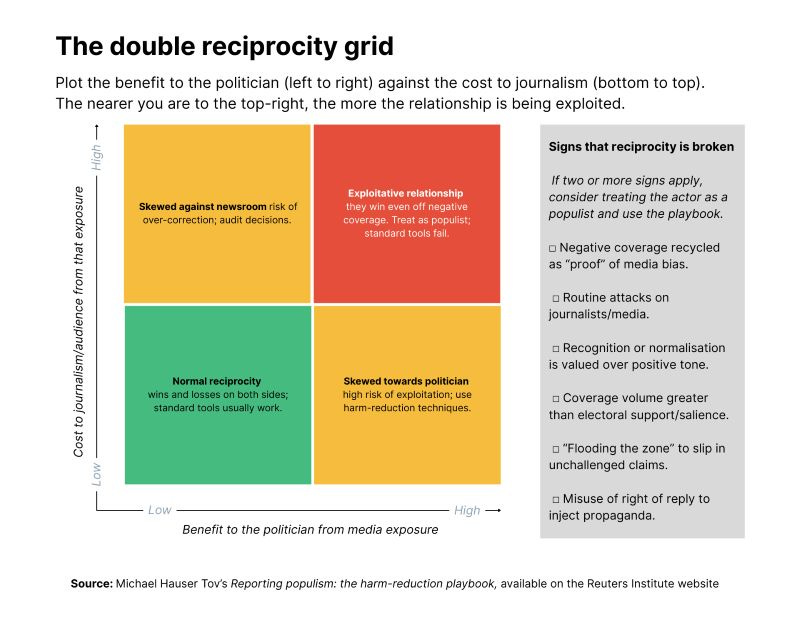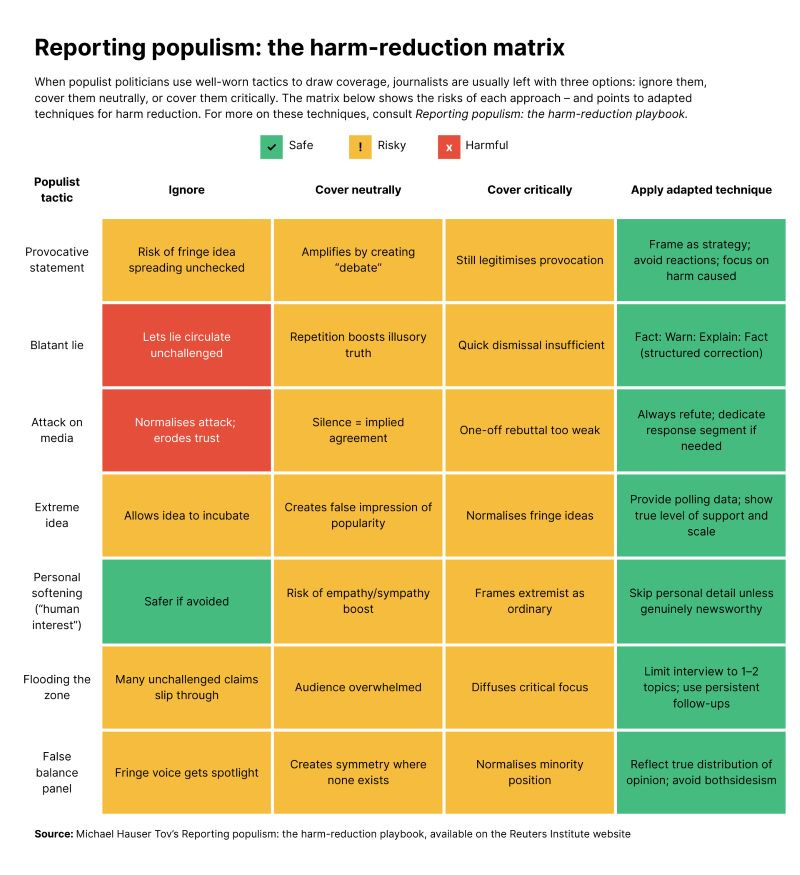We Already Know How to Cover Trump's Lies. So Why Aren't Newsrooms Doing It?
A new playbook from the Reuters Institute lays out concrete techniques for covering authoritarian politicians. The problem isn't figuring out what to do — it's getting anyone to actually do it.
Michael Hauser Tov, chief political correspondent at Haaretz, has a new report out from the Reuters Institute for the Study of Journalism about covering what he calls “populist” politicians. And while I have some quibbles with the framing (I’ll get to that), the actual substance of his work is excellent and something I wish more newsrooms would pay attention to.
The central problem Tov identifies is one we’ve all watched play out in real time: the normal rules of political coverage don’t work anymore. Ignoring provocative statements lets them spread unchecked. Covering them neutrally amplifies them and creates a false sense of legitimate debate. Even critical coverage often backfires, giving the politician status and feeding their “the media is out to get me” narrative.
Tov’s insight is that we need to treat this like harm reduction rather than trying to achieve some impossible ideal of “balance.” He’s not saying don’t cover these politicians. He’s saying cover them differently, with specific techniques designed to minimize the damage they can do to democratic discourse.
The playbook he’s put together includes concrete, practical advice that any newsroom could implement. Before airing a live interview with someone who lies constantly, warn viewers what’s coming. When correcting lies, use a specific method that starts and ends with the truth rather than the falsehood. Replace vague language like “political firestorm” with actual numbers. Stop treating provocative statements as legitimate political debate and start framing them as strategy.
First, about that terminology. Tov uses “populist” throughout his report, and he offers a checklist for identifying when to switch to “harm-reduction coverage” of these figures. The criteria: politicians who use “people vs corrupt elite” framing and have broken reciprocity with the media (meaning criticism fuels them, they routinely attack journalists, they recycle negative coverage as proof of bias, etc.).
Fair enough. But calling these politicians “populists” feels like exactly the kind of softened catch-all language Tov himself warns against later in the report. His own advice: “Name the behaviour, not the category. Skip the softened catch-all language (’populist’). Say what they did: spread a conspiracy theory; made racist statements; incited harassment.”
Right. So why are we using “populist” as the umbrella term here?
Bernie Sanders is a populist. He rails against elites and champions ordinary people. That doesn’t make him remotely comparable to someone like Trump, who spreads conspiracy theories, makes racist statements, incites harassment, and actively works to undermine democratic institutions. The problem isn’t populism as a political style. The problem is authoritarianism, fascism, far-right extremism—pick your term, but let’s at least be accurate about what we’re describing.
This matters because the choice of language shapes how we think about the problem. “Populist” suggests someone’s just really good at connecting with voters, maybe a bit bombastic. It obscures what’s actually happening: deliberate attacks on democratic norms, systematic lying, and often explicit authoritarianism.
But I’m willing to set that aside for now because Tov’s analysis of why standard coverage fails is spot on. He identifies three default approaches journalists tend to take, and explains why each one backfires. Ignore the provocative statement? It spreads unchecked elsewhere. Cover it neutrally? You’ve created a phony debate and conferred status on something that doesn’t deserve it. Cover it critically? You still confer status, and you’ve handed them ammunition for their “the media is biased against me” script.
The key insight here is about broken reciprocity. In normal political coverage, there’s give and take. A politician benefits from positive coverage and suffers from negative coverage. Everyone understands the rules. But these politicians have figured out how to game the system so they win either way. Status matters more than tone. Getting covered at all — even negatively — is the goal because it establishes them as a legitimate part of the political conversation.
And once you understand that dynamic, you realize the solution isn’t less coverage. It’s different coverage.
So what does different coverage actually look like? Tov offers a list of specific techniques, and the thing I appreciate most about them is that they’re practical. These aren’t abstract principles about “restoring trust” or whatever. They’re concrete changes newsrooms could make tomorrow.
Prebunk before going live. If you’re about to air an interview with someone who lies constantly, tell your audience that up front. Remind them this person has lied before. Warn them what manipulation tactics to expect. Research shows that advance warning is way more effective than trying to clean up the mess afterward. This one seems so obvious, and yet how many times have we watched networks air Trump speeches or interviews with zero context beforehand?
Don’t headline the reaction. When someone makes a provocative statement, don’t write “Statement X sparks outrage” or “Critics slam politician over inflammatory remarks.” That framing turns a deliberate provocation into a legitimate political debate. Instead, describe what was actually said and who it harms. Focus on impact, not on the outrage cycle the politician was trying to generate in the first place.
Use the FWEF method for correcting lies. This stands for Fact-Warn-Explain-Fact. Lead with the truth. Warn the audience they’re about to hear a lie. Explain how the lie misleads. Then restate the truth—multiple times if you can. The structure matters because people remember what they hear most often, and if you spend more time repeating the lie than the correction, you’ve just helped spread the misinformation.
Stop with the false balance. If you’re going to platform “both sides,” show the actual distribution of opinion. Don’t present it as 50-50 when it’s really “90 climate scientists say this policy would be disastrous and one guy from a think tank disagrees.” The audience deserves to know where the weight of expertise actually lies.
Quantify instead of dramatizing. Replace “political kerfuffle” with “a dozen members of Congress criticized.” Replace “growing calls for” with the actual number of people calling for something. Vague language inflates the importance of things that might not actually be important. Numbers keep everyone honest.
Keep interviews tight. One or two topics, persistent follow-ups. Don’t let someone dodge a question by pivoting to five other subjects. This is about not letting them “flood the zone” with claims you can’t possibly fact-check in real time. Pin them down.
Protect the right of reply, but don’t let it become a propaganda vehicle. If someone responds to your story with a statement full of lies and irrelevant attacks, you can cut those parts. Right of reply doesn’t mean you have to print whatever nonsense they send you. Add your own corrections where needed.
These techniques don’t cost money. They don’t require some radical reimagining of journalism. They just require thinking about coverage differently and being willing to break from the both-sides muscle memory that’s been drilled into journalists for decades.
For those who would like to financially support The Present Age on a non-Substack platform, please be aware that I also publish these pieces to my Patreon.
In other news…
“Anti-woke” former New York Times opinion columnist Bari Weiss has just been named the new editor-in-chief of CBS News.
Paramount is expected to announce on Monday that it’s acquiring Bari Weiss’s The Free Press for roughly $150 million and installing Weiss as CBS News’ first-ever editor-in-chief. Yes, you read that right. Bari Weiss, a 41-year-old opinion writer with zero broadcast news experience, will be guiding the editorial direction of one of the three major broadcast news networks in the country.
The organizational structure here is bizarre and telling. Weiss won’t report to CBS News President Tom Cibrowski, who’s sticking around to handle production. Instead, she’ll report directly to Paramount CEO David Ellison, completely bypassing the normal chain of command. The Free Press will operate as its own thing within the company, but Weiss will have her hands on CBS News editorial decisions.
This is a disaster.
I’ve written about Weiss before. Back in 2019, when I was at Media Matters, I documented how she and fellow New York Times columnist Bret Stephens had turned that paper into a moral panic factory over “free speech on campus,” concern trolling about college students while platforming genuinely harmful ideas. She left the Times in 2020, claiming she’d been targeted by colleagues for being “insufficiently woke” after she defended a Tom Cotton op-ed that called for using the military against Black Lives Matter protesters.
Since launching The Free Press, Weiss has built a brand around being a “free speech” crusader and “anti-woke” warrior. More recently, her outlet published a truly reprehensible piece claiming that viral images of gaunt, starving Palestinian children in Gaza should be dismissed as “pro-Hamas propaganda” because some of the children had pre-existing medical conditions — as if that somehow explains or justifies their starvation.
And now she’s going to be setting editorial direction at CBS News. At a network that just settled a $16 billion lawsuit with Donald Trump over an edited Kamala Harris interview for $16 million. At a network that’s been in third place and struggling. At a network with a nearly century-long history that includes Edward R. Murrow and Walter Cronkite.
This isn’t about “balance” or “fixing liberal bias” or whatever other nonsense is going to get thrown around to justify this. This is about the right taking over mainstream media institutions, one by one. And CBS News just became the latest casualty.








This is excellent, but I kept looking for the answer to the question in the headline: Why don't they do these things to improve their reporting? And then there's the answer in the second item: The billionaire boss tells 'em they can't.
Noted framing issues aside and agreed upon, this does seem like a useful statement of principles, if a bit self-evident. I just hope we're not too far gone to appreciate it. What good is fact checking when a certain portion of the population regards facts themselves as a form of "bias?" I don't want to be downright defeatist, but we're in a really tough spot fighting against the torrents of misinformation pouring out on the daily. Where do we go when people aren't merely susceptible to believing the lies, but willing to do so?